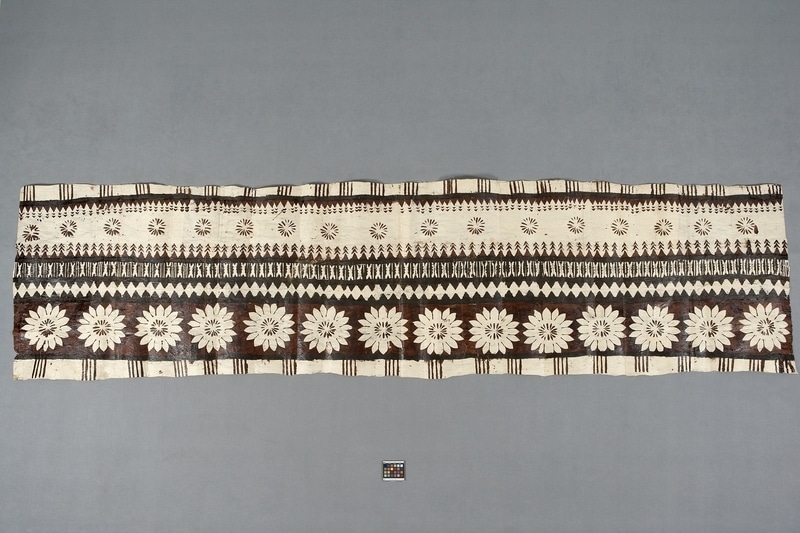Tapa Cloth Item Number: C1253 from the MOA: University of British Columbia

Description
The cloth is rectangular and natural in colour with designs painted in black and dark red. There is a narrow border along the edges decorated only with bunches of four red lines. Inside the borders are four horizontal panels. The first panel is wide and has large natural coloured flowers repeated on a red background. The next panel is thin and has natural coloured diamonds on a black background. The next panel is thin and has natural coloured, elongated X’s separated by double lines on a black background. The final panel is wide and has red sunburst designs bordered by triple rows of triangles on a natural coloured background. The cloth is made of two narrow pieces of cloth joined together in the centre.
History Of Use
Barkcloth, often referred to as tapa, is one of the most distinctive products of the diverse cultures of the Pacific Islands. The name is derived from the Samoan word tapa, which means the undecorated edge of a piece of barkcloth, and the Hawaiian word kapa, a variety of barkcloth. Tapa was probably brought to the Pacific Islands thousands of years ago with the ancestors. Those who make tapa cloths continue to generate techniques and designs that serve both utilitarian and ceremonial purposes.
Item History
- Made in Nalebaleba, Fiji before 1959
- Collected between 1958 and 1959
- Owned by Cyril S. Belshaw before February 1959
- Received from Cyril S. Belshaw (Donor) during February 1959
What
- Name
- Tapa Cloth
- Identification Number
- C1253
- Type of Item
- tapa cloth
- Material
- mulberry bark and paint
- Manufacturing Technique
- pounded and stamped
- Overall
- height 318.0 cm, width 81.0 cm
Who
- Culture
- Fijian
- Previous Owner
- Cyril S. Belshaw
- Received from
- Cyril S. Belshaw (Donor)
Where
- Holding Institution
- MOA: University of British Columbia
- Made in
- Nalebaleba, Fiji
When
- Creation Date
- before 1959
- Collection Date
- between 1958 and 1959
- Ownership Date
- before February 1959
- Acquisition Date
- during February 1959
Other
- Item Classes
- textiles
- Condition
- good
- Accession Number
- 2175/0010